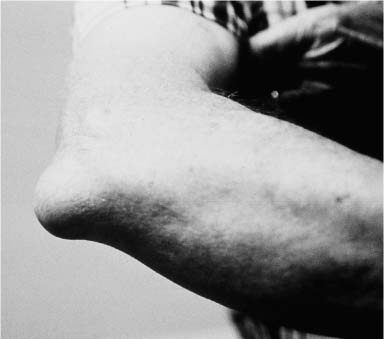Case 48 A 55-year-old right-hand-dominant man presents with a 2-week history of posterior elbow pain and swelling without a predisposing event or injury. He complains primarily of redness and pain at the posterior elbow, as well as a prominent swelling. He denies any systemic symptoms such as fever or chills. Range of motion of the elbow is normal, but the patient reports pain with maximum elbow flexion. Range of motion is otherwise painless. The patient has normal stability of the elbow and is neurovascularly intact. A 3 × 4 × 2 cm mildly erythermatous and locally warm fluid-filled mass is present posteriorly over the olecranon process. This mass is mildly to moderately tender to palpation. Surrounding erythema and mild induration is present. No skin lesions or abrasions are seen (Fig. 48–1). Figure 48–1. Photograph of the affected elbow. 1. Triceps tendon rupture 2. Olecranon fracture 3. Olecranon bursitis 4. Posterior elbow tumor Anteroposterior (AP) and lateral radiographs are normal, except for soft tissue swelling in the posterior elbow. • Maintenance of a compressive dressing following olecranon bursal excision for 1 to 2 weeks reduces the chance of hematoma or recurrent fluid collection postoperatively. PITFALL • If an olecranon osteophyte is to be removed at the same time the olecranon bursa is excised, a minifluoroscopic unit or intra-operative radiograph is recommended to confirm complete removal of the osteophyte. These osteophytes can sometimes be difficult to palpate deep to the triceps tendon and radiographs are helpful. Olecranon Bursitis. Olecranon bursitis is diagnosed based on a fluid-filled mass and localized tenderness in the area of the olecranon bursa. Olecranon bursitis occurs very commonly and is sometimes related to a traumatic event. It is usually very apparent and easily diagnosed, but difficulty is sometimes encountered in differentiating a septic from an aseptic bursitis. Signs of systemic involvement, such as fever or chills, favor a septic etiology. Also, any evidence of an abrasion or skin injury around the bursa may allow for the introduction of bacteria into the bursa. If the fluid collection is large enough to cause significant activity restrictions, is very painful, or septic etiology is suspected, then aspiration of the bursa is recommended.
History and Physical Examination
Differential Diagnosis
Radiologic Findings
Diagnosis
Stay updated, free articles. Join our Telegram channel

Full access? Get Clinical Tree









